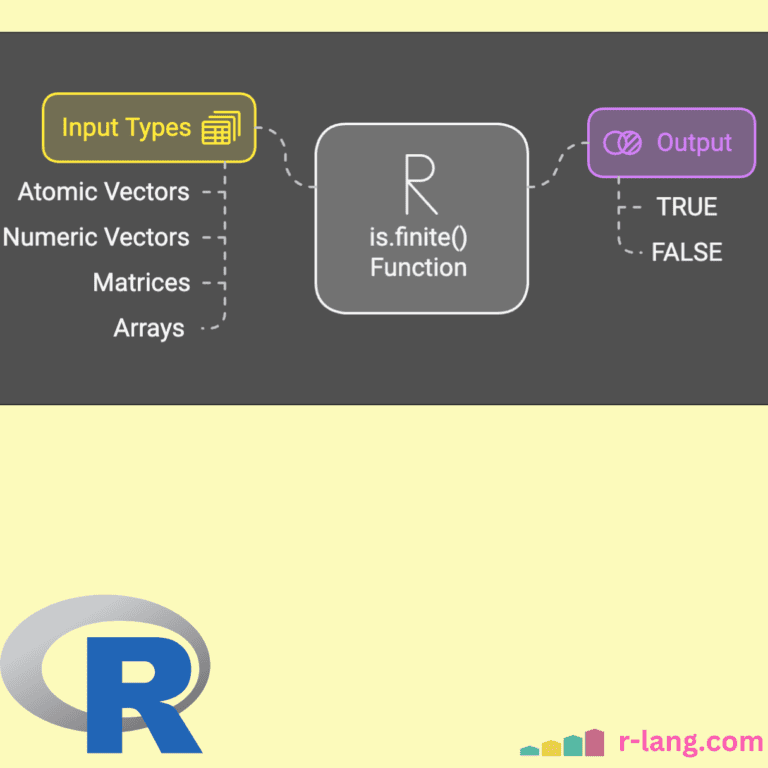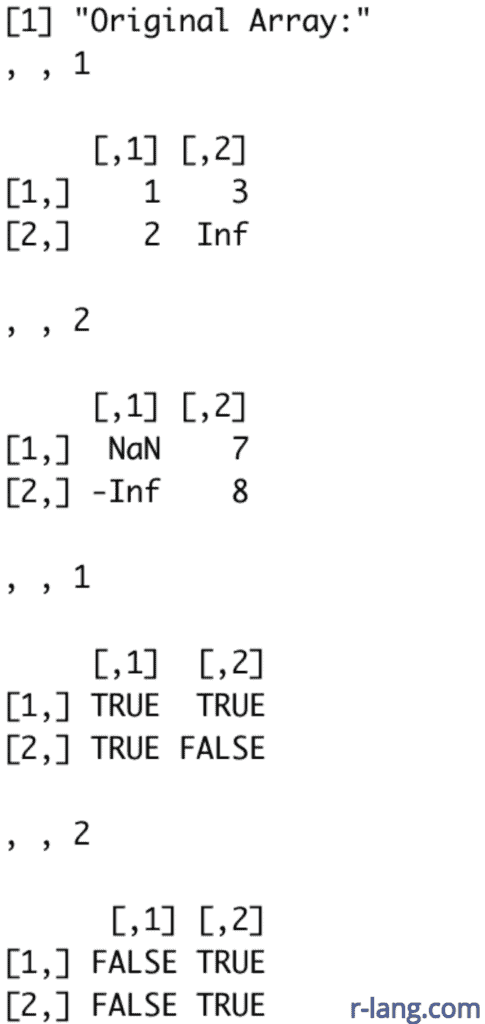In the process of data cleaning, you often need to identify and remove non-finite values from the datasets before analysis. The actual non-finite (infinite) values are Inf(positive infinity) and –Inf(negative infinity). NA and NaN are special cases.
is.finite()
R is.finite() function checks whether input objects are finite. By default, it handles atomic vectors, but it can be numeric vectors, matrices, and arrays. It returns a logical vector of the same length where TRUE suggests that the corresponding element is a finite number, and FALSE suggests that it is not.
The is.finite() method does not work directly with Data Frames because it is not a list of vectors of potentially different types. If you try to work with data frames, it will give you an error like this: “Error in is.finite(df) : default method not implemented for type ‘list'”.
Syntax
is.finite(obj)Parameters
| Name | Value |
| obj | It is an input R object that will be checked for finite values. |
Return value
- If an element is a regular number, is.finite() returns TRUE.
- If an element is Inf or -Inf, it returns FALSE.
- If an element is NA (Not Available) or NaN (Not A Number), it returns FALSE.
Finite and Infinite Numbers
vec <- c(1, -1, Inf, 0, -Inf)
is.finite(vec)
# Output
# [1] TRUE TRUE FALSE TRUE FALSE
You can see that the output vector’s length is the same as the input vector’s length, and infinite numbers are replaced by FALSE. NaN represents an undefined numeric number.
Passing “NA”
vec <- c(1, NA, -1, NA)
is.finite(vec)
# Output
# [1] TRUE FALSE TRUE FALSE
Extracting finite values from the vector
Using vector indexing, we can extract the finite values from the vector with the help of is.finite() function.
vec <- c(1, NA, -1, NA)
finite_vals <- vec[is.finite(vec)]
print(finite_vals)
# Output: [1] 1 -1Matrices
We can also check for finite values in the matrix. It will return TRUE for a finite number in individual elements and FALSE otherwise.
mat <- matrix(c(1, NaN, 3, Inf, 5, 6), nrow = 2, ncol = 3)
print("Finite values in matrix:")
print(is.finite(mat))
# Output
# [1] "Finite values in matrix:"
# [,1] [,2] [,3]
# [1,] TRUE TRUE TRUE
# [2,] FALSE FALSE TRUEYou can see that the output matrix has the same size as the input matrix. Only its elements are boolean values.
Arrays
Let’s create a 3D array with a mix of finite, infinite, and NaN numbers.
# Defining an array
arr <- array(c(1, 2, 3, Inf, NaN, -Inf, 7, 8), dim = c(2, 2, 2))
print("Original Array:")
print(arr)
# Applying is.finite() function to the array
finite_arr <- is.finite(arr)
print(finite_arr)Output
You can see that the output is a logical array of the same dimension as an input array.
That’s all, mates!

Krunal Lathiya is a seasoned Computer Science expert with over eight years in the tech industry. He boasts deep knowledge in Data Science and Machine Learning. Versed in Python, JavaScript, PHP, R, and Golang. Skilled in frameworks like Angular and React and platforms such as Node.js. His expertise spans both front-end and back-end development. His proficiency in the Python language stands as a testament to his versatility and commitment to the craft.




